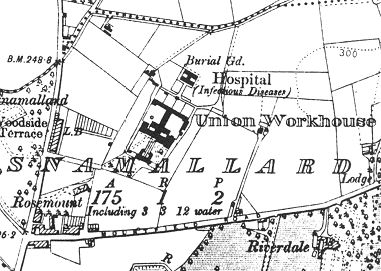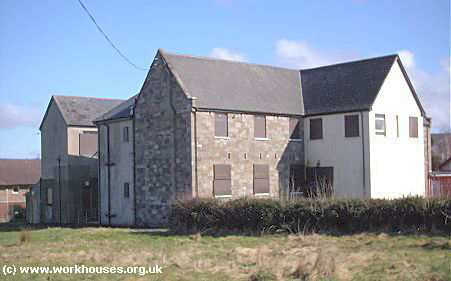Omagh, Co. Tyrone
Omagh Poor Law Union was formally declared on the 9th May 1839 and covered an area of 272 square miles. Its operation was overseen by an elected Board of Guardians, 30 in number, representing its 29 electoral divisions as listed below (figures in brackets indicate numbers of Guardians if more than one):
Co. Tyrone: Athenry, Beragh, Camderry, Camowen, Carrickmore, Clanabogan, Creggan, Derrybard, Dervaghroy, Dromore, Drumquin, Dunbreen, Fallaghearn, Fintona, Gorsnacreagh, Greenan, Killyclogher, Leskinore, Loughmacrory, Loughmuck, Mountfield, East Mountjoy Forest, West Mountjoy Forest, Mullagharn, Mullaghslin, Omagh (2), Six-mile Cross, Tattymoyle, Tullyclunagh.
The Board also included 9 ex-officio Guardians, making a total of 39. The Guardians met each week at 1pm on Saturday.
The population falling within the Union at the 1831 census had been 66,388 with divisions ranging in size from Creggan (population 660) to Omagh itself (5,464).
The new Omagh Union workhouse was erected on a six-acre site to the north of Omagh. Designed by the Poor Law Commissioners' architect George Wilkinson, the building was based on one of his standard plans to accommodate 800 inmates. Its construction cost £6,557 plus £1,343 for fittings etc. The workhouse was declared fit for the reception of paupers on 24th August 1841 and admitted its first inmates on the same day.
The workhouse location and layout are shown on the 1908 OS map below.

Omagh workhouse site, 1908.
The buildings followed Wilkinson's typical layout. An entrance and administrative block at the south contained a porter's room and waiting room at the centre with the Guardians' board room on the first floor above.
The main accommodation block had the Master's quarters at the centre, with male and female wings to each side. At the rear, a range of single-storey utility rooms such as bakehouse and washhouse connected through to the infirmary and idiots' wards via a central spine containing the chapel and dining-hall.
During the famine in the mid-1840s, sleeping galleries were erected to accommodate an additional 200 inmates. Fever patients were initially accommodated in Omagh Fever Hospital. However, as conditions worsened, the whole workhouse was turned over for use as a temporary fever hospital, with able-bodied inmates being rehoused in Omagh. During this time, the Guardians' meeting were also relocated to Omagh courthouse. A purpose-built fever hospital was subsequently erected to the north of the workhouse.
In 1895, Omagh was visited by a "commission" from the British Medical Journal investigating conditions in Irish workhouse infirmaries. Like many others that were examined, the Omagh workhouse suffered from antiquated sanitary facilities such as a lack of running water in the infirmary. The nursing staff were overstretched and at night, no nurse was provided nor any means to summon help by the inmates who were locked in their wards. Further details are available in the full report.
At the 1901 census, the population of the Union was 38,553 with 10 officials and 210 inmates in the workhouse.
The entrance block was later used as offices by Omagh Rural District Council but was demolished in around 1962. The main workhouse buildings had various uses as offices and stores, and also remained the home of the last master, Thomas Monsell, after the Union was dissolved. The buildings were demolished in about 1967. Only the fever hospital now survives, as part of Omagh General Hospital.

Omagh former fever hospital, 2004.
© Kathleen McGale.
Staff
- Masters: Robert Tener, James Young, George Mackey, Henry Beggs, Joseph Rodgers, John Kelly, Charles McLaughlin, Thomas Monsell.
- Clerks: Joseph McKnight, William Johnston McKnight, William Cathcart, Patrick Gormley, Robert Parke, Joseph P Robinson.
Records
Note: many repositories impose a closure period of up to 100 years for records identifying individuals. Before travelling a long distance, always check that the records you want to consult will be available.
- Public Record Office of Northern Ireland, 2 Titanic Boulevard, Titanic Quarter, Belfast BT3 9HQ. Holdings include: Board of Guardians' minutes (June 1839 - Sept 1948); Indoor relief lists (1940-49); Births (1867-1905); Tobacco book (1938-4); Farm account book (1936-44); etc.
Bibliography
- Crossman, V (2006) Politics, Pauperism and Power in Late Nineteenth-century Ireland
- Gould, Michael H (1983) The Workhouses of Ulster
- Gray, P (2009) The Making of the Irish Poor Law, 1815-43
- Johnston, J (1996) Workhouses of the North West
- O'Connor, J (1995) The Workhouses of Ireland
Links
- None.
Unless otherwise indicated, this page () is copyright Peter Higginbotham. Contents may not be reproduced without permission.


